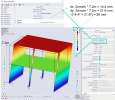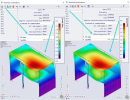Calculation and display of the initial imperfections
New type of analysis
Global imperfections (GI) which are defined within the library of initial global geometrical imperfections, are available to be calculated as a separate type of analysis (#A) since SCIA version 24.0. It is also possible to calculate only selected GI items (#B). In case the GI is assigned to a nonlinear combination, the analysis of this GI is automatically triggered before the calculation of the corresponding nonlinear combination. Also all the necessary analyses that are required for the GI are automatically initiated (e.g. linear or nonlinear stability analysis or linear static analysis, depends on the selected GI type).
Internal note: During the analysis of global imperfections, the imperfection are treated as "imperfection_case", which is analogical to load case. In order to apply the result of this analysis (the initial imperfection itself) as an initial shape for other static structural analyses, the calculations of these imperfections are conducted in 3rd order (large deformations), where Newton Raphson method with 5 increments and 20 iterations is internally considered. Therefore, if global imperfections are to be implemented, 3rd order analysis always runs on the background to determine these initial geometries. Afterwards, it is possible to apply these initial geometries on either geometrically nonlinear or also geometrically linear analyses. Utilization of the initial imperfection with geometrical nonlinearity is recommended.
Global imperfections - results
The results of Global imperfection analysis are available to be graphically displayed as these items:
- nodal displacements
- 1D deformations
- 2D deformations
- 3D deformations (example in the figure below for the simple inclination)
In order to display the global imperfections, it is necessary to set the property of "type of load" to "imperfection". Then the list of calculated imperfections is available.
Results of the nonlinear combination which uses geometrical imperfection
The calculated and displayed deformation is always considered from the imperfect model, e.g. it does not represent the total deformation from the ideal shape, but the overall deformation from the imperfect shape. An example of two nonlinear combinations, one with GI and one without is provided below (the difference is rather negligible, as in this case the load was small)




